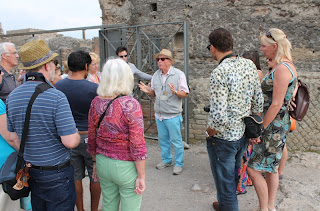When it was rediscovered, after being dug out some 1,700 years later in 1748, the story began to unfold as to its destruction. Many dwellings still have their walls intact, and modern science in conjunction with modern excavation methods, can now bring 'life' to this dead town - fascinating stuff I have to say! Both of us were of the opinion that both tour content (we had a good guide) and the site itself, was of such value that this is a must see when you are in the area. The tour by real guide (you can have a self guided tour with an audio gadget in your ear) takes about two hours. The up side of this is that you are taken to the interesting parts quickly and don't struggle finding your way around the place - it's bigger than you think!
Getting the low down -
- on a piazza in Pompeii
Another advantage of having a guide is that he chooses his patch to give you the information, he knows you will be taking photos, therefore making sure you have the picture you need.
Choosing his patch -
- setting the scene in the former market square
Tests and research are ongoing and that is part of the fascination in visiting Pompeii, like here where the deterioration of a corpse is monitored and recorded, covered in ash resulted in the bodies being mummified and therefor preserved - the skeleton and bone structure is intact.
Figurines of marble and stone adorned many homes in Pompeii and some fine examples can be seen.
Marble figurines
Stone figurines adorning the walls of a Roman bathhouse
We were taken through the remains of former homes where mosaic floors and wall decorations have been dusted off and restored to some of their former glory.
Mosaic floor and garden
Art on the walls
We were shown the 'red light' district of former Pompeii. Interesting was how our guide compared modern day disco's to what the Romans would have called a 'pleasure house'. To show a well endowed Roman's anatomy to the outside world, more so when he lived in the red light district, the 'ladies' would have a plaster copy adorn the wall above the front door of the 'pleasure house'. Further, a drawing or some form of expressive art in Kama Sutra style, may also be added to the entrance so as to show the 'house speciality' - seriously!
Outside decoration in the -
- former 'red light' district
We also learnt that part of the demise of the Roman Empire was the fact that people were dying of lead poisoning, not that they knew it at the time. Much of Pompeii's lead for water pipes, were sourced in Cornwall, England.
Lead water pipe
The road from Rome to southern Italy and Sicily also went through Pompeii. That the Romans could achieve what they had, comes as no surprise when you walk the streets of Pompeii in the company of a good guide. As said before the town comes to life and you can visualise how people went about their daily business.
From Rome to Sicily, through Pompeii
We thoroughly enjoyed this visit, we learnt much and we left the place feeling enriched by the experience and knowledge gained.
Pompeii amphitheatre
Park in modern day Pompeii











.JPG)






No comments:
Post a Comment